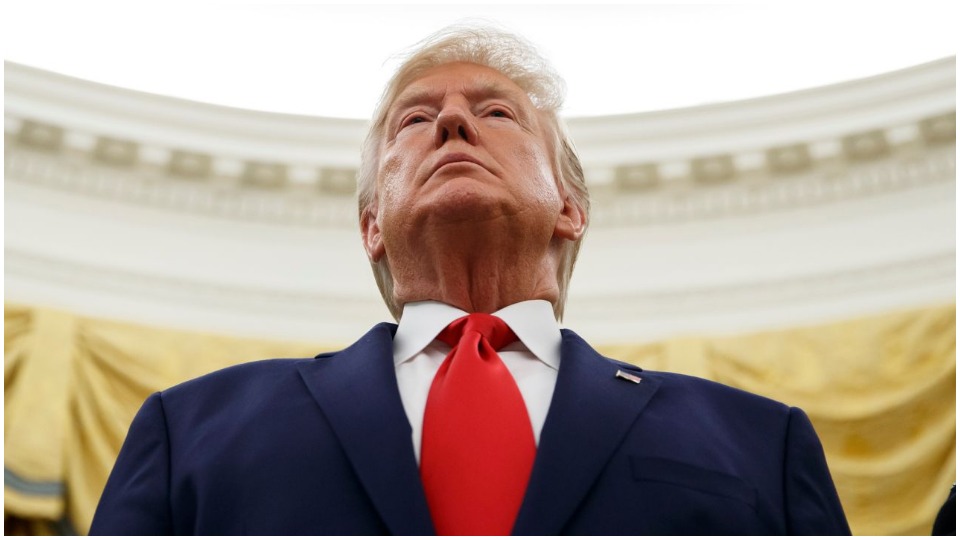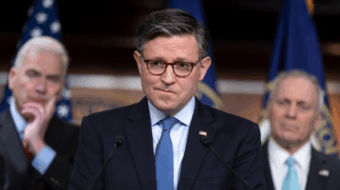
The seven prosecutors—Democratic House members who will serve as impeachment managers—have been selected, and all of them are experienced litigators to one degree or another. U.S. Supreme Court Chief Justice John Roberts has taken the oath as trial adjudicator, and all 100 U.S. Senators have been sworn in as jurors for the impeachment trial of Donald John Trump, president of the United States.
Behind the pomp and circumstance which marks the beginning of a formal impeachment trial, new evidence against the president’s conduct continues to pile up.
The latest shakeup comes from the independent, non-partisan Government Accountability Office. In an opinion issued by the government watchdog Thursday, the GAO concluded the White House violated the Impoundment Control Act when it withheld appropriated funds to aide Ukraine last summer to advance Trump’s personal political agenda (Impeachment Article I—Abuse of Power).

“Faithful execution of the law does not permit the President to substitute his policy priorities for those that Congress has enacted into law,” the report said. “OMB withheld funds for a policy reason, which is not permitted under the Impoundment Control Act (ICA)…. Therefore, we conclude that OMB violated the ICA.”
The GAO’s opinion—which sadly carries no disciplinary power—zeroed in on the exact reasons for Trump’s impeachment, and gave a soft “guilty” verdict.
Later in the evening Thursday, Giuliani crony Lev Parnas continued his damning interview with MSNBC’s Rachel Maddow. On Wednesday, he had confirmed the nature and full reach of the Trump-led conspiracy in which he, Vice President Mike Pence, Attorney General William Barr, and GOP Rep. Devin Nunes had all been involved. In the second interview installment, Parnas revealed that his Trump-team attorneys had visited him in prison and pressured him to “be a good boy” and sacrifice himself, taking the fall for the president.
With the Parnas papers and statements being dumped into the public record via the media at the opening of the trial, perhaps it will serve as a detour around the White House’s continuing congressional obstruction (Impeachment Article II).
Perhaps the weight and moral implications of aiding the president in his corruption schemes finally took its toll on those like Parnas who were “just following orders” or looking for ways to enrich themselves as part of the Trump operation. Then again, as Parnas seemed to confirm, like a mobster turned stool pigeon, maybe some of the president’s associates have just started to fear for their own safety.
As we head into this historic impeachment trial, only the third in our nation’s history–Nixon’s impeachment did not get to the trial stage in the Senate, he resigned before–let’s quickly break down what it all means and how it will unfold (or not) in the weeks to come.
What is impeachment?
The formal process by which a legislative body (Congress) levels charges against an elected government official. In relatable terms, think of it as a formal indictment in a criminal trial. There’s no immediate removal from office; it’s just a statement of fact regarding the alleged crimes committed.
Where does the power of impeachment come from?
Impeachment is found in Article One of the United States Constitution and gives the House of Representatives the sole power of impeachment, while the Senate has the sole power to try impeachments of government officials. In the event a sitting U.S. president is put on trial (as is happening now), the Constitution says it will be the Chief Justice of the Supreme Court who will preside over the trial.
Historically, Constitutional framers chose Congress as the impeachment authority because they earnestly believed the power to sanction or discipline executive and judicial misconduct should be held by an electorally accountable body that was not subject to the control of those it was attempting to discipline. That means our votes matter here, and none of this would be taking place without the victory of taking back the House from Republicans in 2018.
Alexander Hamilton, writing in The Federalist Papers: No. 69, pitched impeachment as a mechanism to prevent any future democratic crisis: “The President of the United States would be liable to be impeached, tried, and, upon conviction of treason, bribery, or other high crimes or misdemeanors, removed from office; and would afterward be liable to prosecution and punishment in the ordinary course of law….”
So this trial is also about putting a check on Trump’s threats to U.S. democracy.

What is an “impeachable offense”?
“Treason, Bribery, or other high Crimes and Misdemeanors.”
What those actually mean is ultimately determined by the House Majority at the time. During the attempt to impeach Supreme Court Justice William O. Douglas in 1970, then-Rep. Gerald Ford argued persuasively that an impeachable offense “is whatever a majority of the House [considers it] to be at a given moment in history; conviction results from whatever offense or offenses two-thirds of the other body considers to be sufficiently serious to require removal of the accused.”
The good ol’ gray area of politics. Adding to this puzzling concept of “what is impeachable conduct” is the matter of political partisanship, the unwavering loyalty of party members to their president (please see the current GOP).
What are the basics of the impeachment process in the House?
It begins with the filing of a formal complaint of misconduct in the House of Representatives—anyone, yes, even a private citizen, can request a formal impeachment investigation.
From there, impeachment resolutions are sent to the House Judiciary Committee, or directed to any one of the House’s subcommittees, which begins the formal investigation into the allegations. Once the investigation is complete, it next votes on the articles of impeachment; selects impeachment managers, and presents the articles of impeachment to the Senate.
This is what’s been happening in the House over the past few months and which culminated in the vote to impeach Trump in December and the delivery of the articles to the Senate this week.
How will the impeachment trial proceed in the Senate?
Now that the articles of impeachment have reached the Senate, the chairman of the house managers will ask the Senate to order the appearance of the accused to answer the charges and demand conviction and appropriate judgment. At this point, senators will take over and start the process of deciding how to conduct the trial—seemingly endless paperwork and debates over which witnesses (if any) will be called, how evidence will be presented and considered, which members of the press will be allowed, whether and how proceedings will be broadcast, etc.
Since the impeachment trial of Andrew Johnson in 1886, the Senate has developed and used Rules of Procedure and Practice in the Senate When Sitting on Impeachment Trials.
A critical aspect of this is found in Rule VII, which allows the Chief Justice to rule on all “questions of evidence including but not limited to, questions of relevancy, materiality, and redundancy of evidence and incidental questions.”
Over the years, the rules have not formally changed much, but as we have seen and heard, the Senate will likely tweak or move rules around.
On Wednesday, Senate Majority Leader Mitch McConnell and Senate Minority Leader Chuck Schumer sent a joint letter to members outlining accessibility rules ahead of the impeachment trial.
After the paperwork come opening arguments, scheduled for Tuesday, Jan. 21 in Trump’s impeachment trial. Each side will be given a scheduled amount of time to present their cases for and against the impeachment and removal of the president.
Following opening arguments, the Senate will debate whether to dismiss the impeachment charges or allow the trial to continue and move to call witnesses and allow the introduction of new evidence.
After both parties lay it all on the table, the 100 senators, acting as jurors, will deliberate and eventually hold votes on each article of impeachment.
It will take a two-thirds majority to remove the president from office (67 votes out of 100)—meaning about 20 Republican senators would need to side with Democrats in calling for a conviction. That’s not a likely outcome. But if the Senate were to vote to convict, Trump would be removed from office. It could then take another vote to prevent the president from running for office ever again—needing only a majority vote this time.
Again, with the GOP Senate leaders having already signaled they have no intention of being impartial jurors or of conducting a fair trial, the possibility of a Trump removal remains exceedingly unlikely.
What can we expect in Trump’s impeachment trial?
Far too many “What ifs.”

If Senate Majority Leader McConnell keeps his 51-vote majority in lock-step, he will have the power to shape the trial as he pleases (an awful failing of our democratic experiment). All motions could be stopped, witnesses prevented from speaking, or, the entire trial could even be dismissed.
If it comes down to whether the Senate is faithfully following its own procedural rules, senators could ask the Chief Justice to clarify, and even cast a tie-breaking vote—but that’s it, he may only clarify and enforce the rules, not make them up on the spot.
What comes next in this momentous presidential corruption scandal will be seen starting next Tuesday. In the meantime, who knows what revelations of further Trump crimes and confirmation of previous ones could emerge between now and then? Maybe the president will even tweet out an admission of his own guilt by accident, in ALL CAPS of course.










